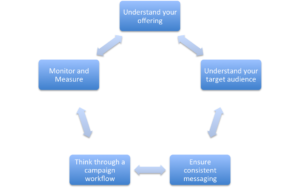 One of the key goals of marketing organizations is to assist and enable sales. This goal gave rise to metrics such as number of leads through marketing and RoI of marketing initiatives. In fact, such measurements are becoming more commonplace as marketing becomes more and more accountable for the budgets they are allocated as well as the actions they take. This is a good thing in my opinion. Why? It forces a marketer to understand the big picture and take considered decisions. The marketer cannot rush headlong into spending money whatever is the current flavour of the season. However, he will be forced to arrive at the best course of action for his business based on market data, previous experience, company culture, available budgets, target audience and business capabilities. A more holistic approach is needed.
One of the key goals of marketing organizations is to assist and enable sales. This goal gave rise to metrics such as number of leads through marketing and RoI of marketing initiatives. In fact, such measurements are becoming more commonplace as marketing becomes more and more accountable for the budgets they are allocated as well as the actions they take. This is a good thing in my opinion. Why? It forces a marketer to understand the big picture and take considered decisions. The marketer cannot rush headlong into spending money whatever is the current flavour of the season. However, he will be forced to arrive at the best course of action for his business based on market data, previous experience, company culture, available budgets, target audience and business capabilities. A more holistic approach is needed.

So how should a marketer approach a campaign in an environment where he has to deliver results that have a tangible impact on the business? Here are 5 steps that a marketer should take to achieve noteworthy results.
5 steps to a marketing campaign
- Do your homework on what you have to offer: As a marketing person, do you really understand what your offering does? What challenges does it address and what benefits does it deliver to the customer? How different is it from what others in the market are offering? How relevant is it to your customer?
- Understand your target audience: Do you have a good handle on who your customer is? Is it the CIO or a business unit head or the CMO? Or is it somebody lower down in the organization? Which geographies are you targeting and what is the size of your customer’s business? These are important considerations which leads to the first critical step in your campaign – the contact database. Do you have a sound list of contacts and does it align with the buyer persona you have defined? If this is not in order, there is every chance that your campaign will not succeed. Don’t underestimate the importance of a good database.
- Messaging for the content: You will end up creating some content for the campaign. Be clear about the messaging you will convey and ensure that it is consistent through the campaign. Also the messaging should be in sync with the public messaging of the offering – on your website, analyst reports, marketing collateral, customer testimonials etc. Who wants to work with a confused seller?
- Arrive at a campaign workflow: Do an inventory of your content assets and map it to what is relevant for your target audience. For example, a business contact will prefer to hear about business trends, problems and ideas on solving them whereas an IT contact will prefer to get a flavour of the business and operational side of technology solutions. Plus you need to be consider what you share with the audience through this campaign. The workflow and content of the workflow has to be carefully planned. For instance, sharing a case study or a brochure at the start is no good. Instead ask yourself these questions – Am I targeting existing or new customers? Is this an awareness building or lead generating campaign? The answers to these questions will determine the kind of content that can be shared. A sound workflow encompassing all digital channels will make sure that you deliver the right messages to your audience.
- Monitoring and measurement: Don’t forget this step is what will determine the success of your campaign efforts within your organization. Be careful about the metrics you want to measure. Make sure it is aligned with your objectives. It is equally important to set pragmatic expectations internally – if you are starting off a campaign for the first time, it does not make sense to expect sales conversions. You should aim for good engagement levels and a few enquiries. Don’t treat the campaign as a one-off exercise; rather it should be the start of an ongoing series of communication with your contact database. Research suggests that a prospect responds after 10 or more touch points typically. So adopt a long-term approach. Obviously, you need to show results for your efforts, but it will be a gradual build-up and may take a couple of campaigns to deliver the kind of results you are expecting.
Clearly launching an effective digital campaign requires conceptual clarity as well as good execution skills. A gap in either area can result in less than desired outcomes. Therefore make sure you have a team that can review effectively. Setup a periodic review process to monitor the progress. Above all ensure you have adequate backing for this effort from seniors to get all the support you can. Good luck with your campaigning efforts!
http://www.prayag.com/blogs/marketing-communication/5-steps-to-launching-high-impact-campaigns/
(This blog first appeared on www.prayag.com)
